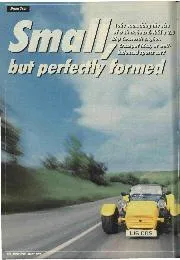

Small, but perfectly formed
Take something the size of a skateboard. Add a 220 bhp Cosworth engine. Crackpot idea, or well-balanced sports car? Westfield. The name conjures memories of a winter fortnight around 10…
WHO WOULD BUILD A” DICER”?
Sir,
Now that the extra-special ” specials ” are so much in the “sporting eye” since their fine performances at Shelsley and elsewhere, it seems the right time to make a few remarks on that other form of” special “—the home-built road motor.
This, of course, is a totally different type of machine, since it is not designed to run in first-class meetings but primarily intended for fast road work. True, it can be used in the smaller club events with some hope of success, but since its compression and gear-ratios are such as will suit pump fuel and fast touring at moderate revs., it obviously won’t develop enough horses to put it anywhere above sports-class performances. Perhaps a few hints on the construction of these motors might prove of interest LETTERS FROM READERS—continued
to anyone who may be thinking of trying his hand. To begin with it will probably cost a lot more than expected (it’s no use hoping will cover the bill if you want a good motor) but the first expenditure is not
money—it’s thought. The general lay-out, purpose of use, performance desired, horse-power tax limit, and any details of personal preference should be carefully taken into account before any material is purchased at all. When this has been settled, the components Should be bought (preferably at a breaker’s yard—they’re cheaper) with an eye to matching them up. For instance, an engine unit with fabric joints to the prop-shaft is easier to adapt to a back axle with a fabric coupling than
if it had a metal universal. A certain amount of alteration is bound to be necessary but in the interests of economy should be kept down to the minimum.
One of the main points to keep in mind is that a good power to weight ratio enables a high final drive to be used, in turn leading to fast road travel without over-revving—so keep the weight down as much as possible.
But what Weight there is must he well distributed (mount the engine well back in the chassis) because a light car is inclined to cavort at high speeds unless this point is given careful attention. Road holding is very important and here one might well follow the example of the ” Fry-kaiser wagen,” the latest Bolster Special, etc., and fit independent frontwheel suspension, since this undoubtedly helps to keep the front wheels attending to their job Of steering the car. Whilst on the subject of steering, if the box and front axle are of different manufacture it is as well to see that the drop arm leverage is suitable, otherwise the finished job may be found to have :a too high or too low ratio for convenient control. If the back axle of the ordinary type is going to be used, it is most important to get One that will stand up to the power given off by the engine. It’s no use, for
instance, fitting an Austin Seven back axle to, say, a 12/50 Alvis ; most axles will stand a fair increase in loading so long as racing starts aren’t indulged in.
Also endeavour to get both axles using similar type wheels, since not only is the finished appearance of the car better, but from the purely utilitarian point of view, one spare wheel is lighter than two. The final point which will make or mar the completed car is the body. Here, of course, personal preference is the only guide for the constructor, but if out and out speed is the end in view something with a tapering tail and an tuidershield is of great benefit. It should be fairly easy to pick up something on this style which only needs repainting to make it presentable. Some people may like to try their hand at making their own bodies, but personally, in my opinion, not one amateur in a hundred can construct a body which does justice to a good piece of engineering. Should it be successful, however, it would undoubtedly put the finishing touch of individuality to the ” In any case, it’s jolly good fun, the work may be hard but the result (if it goes) is worth all the trouble. I am, Yours etc.,
R.G.S.
N.20.